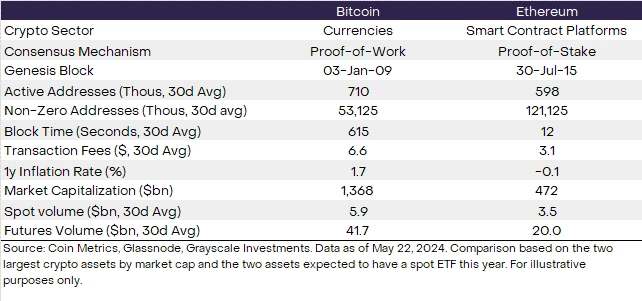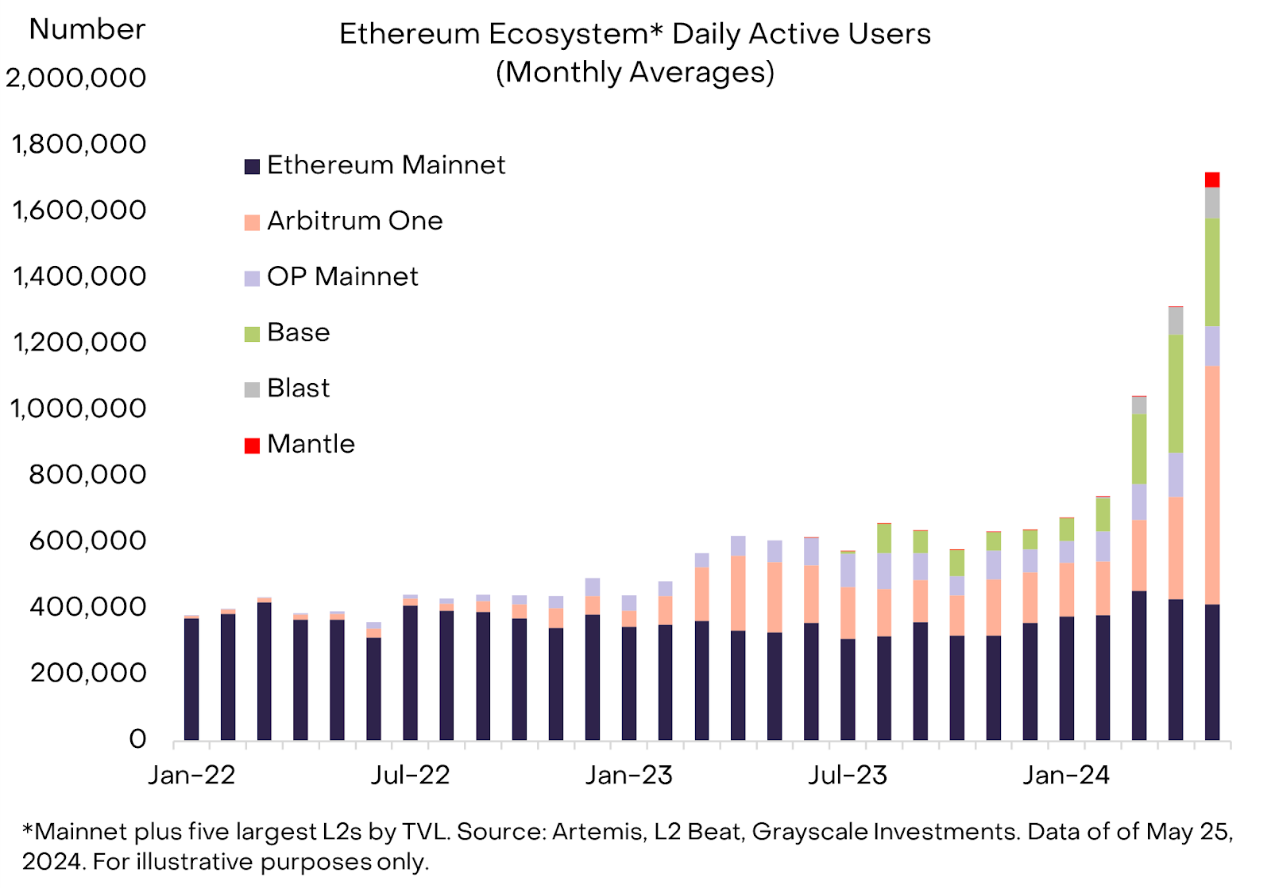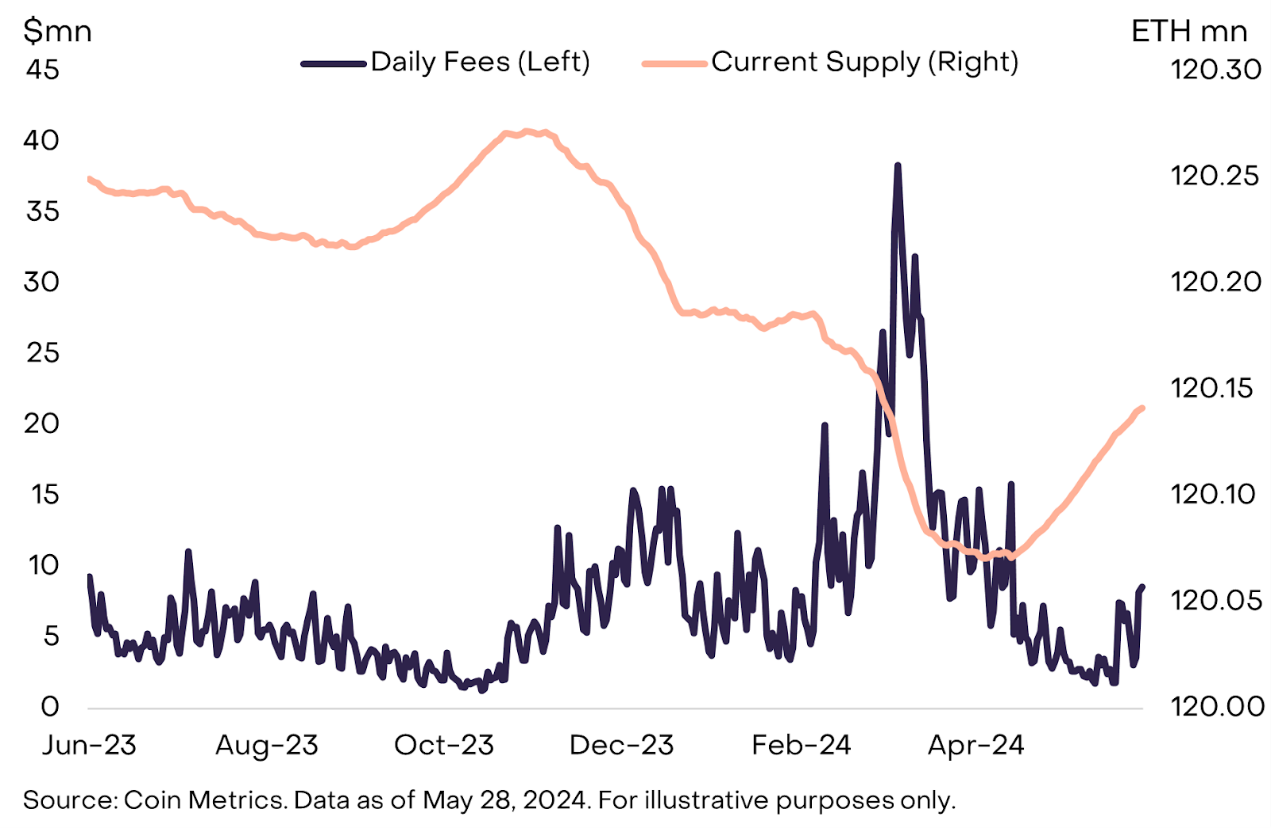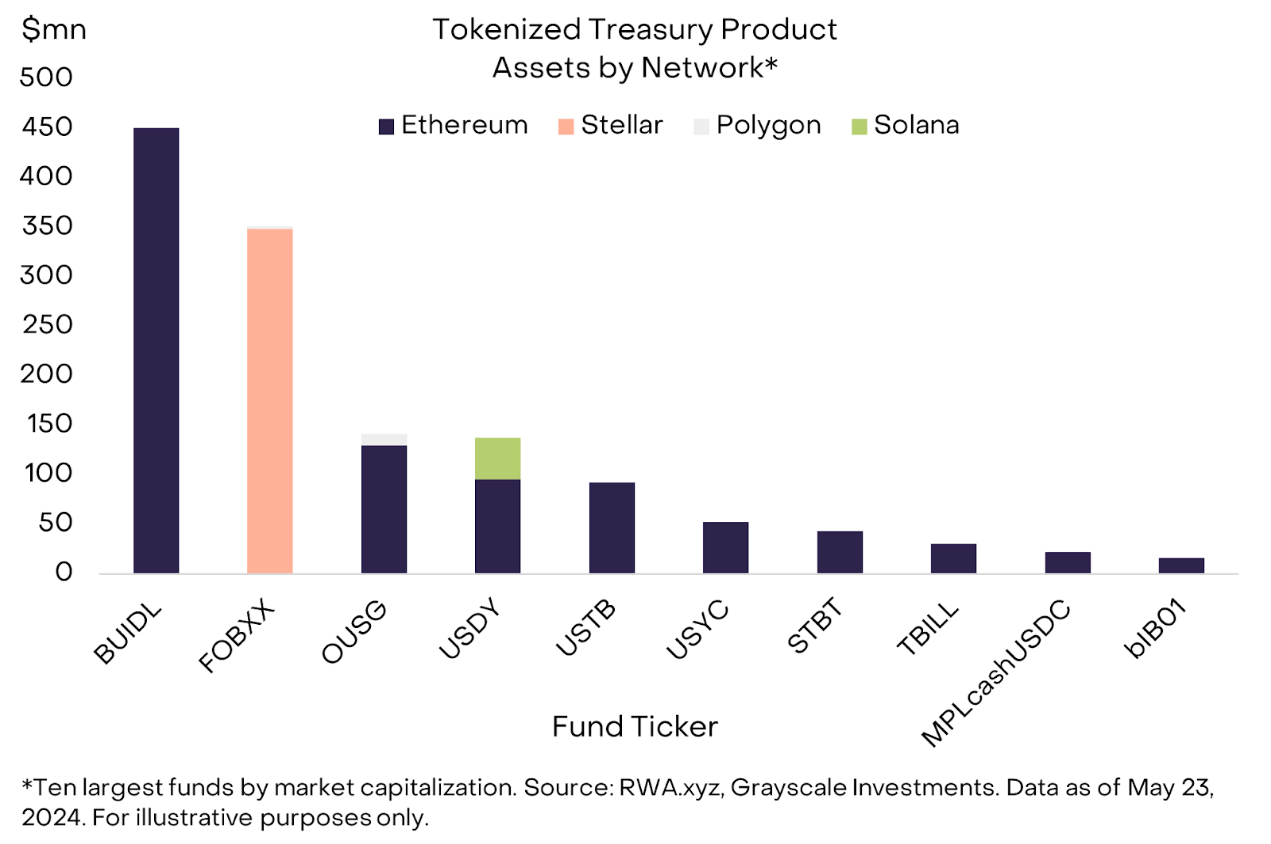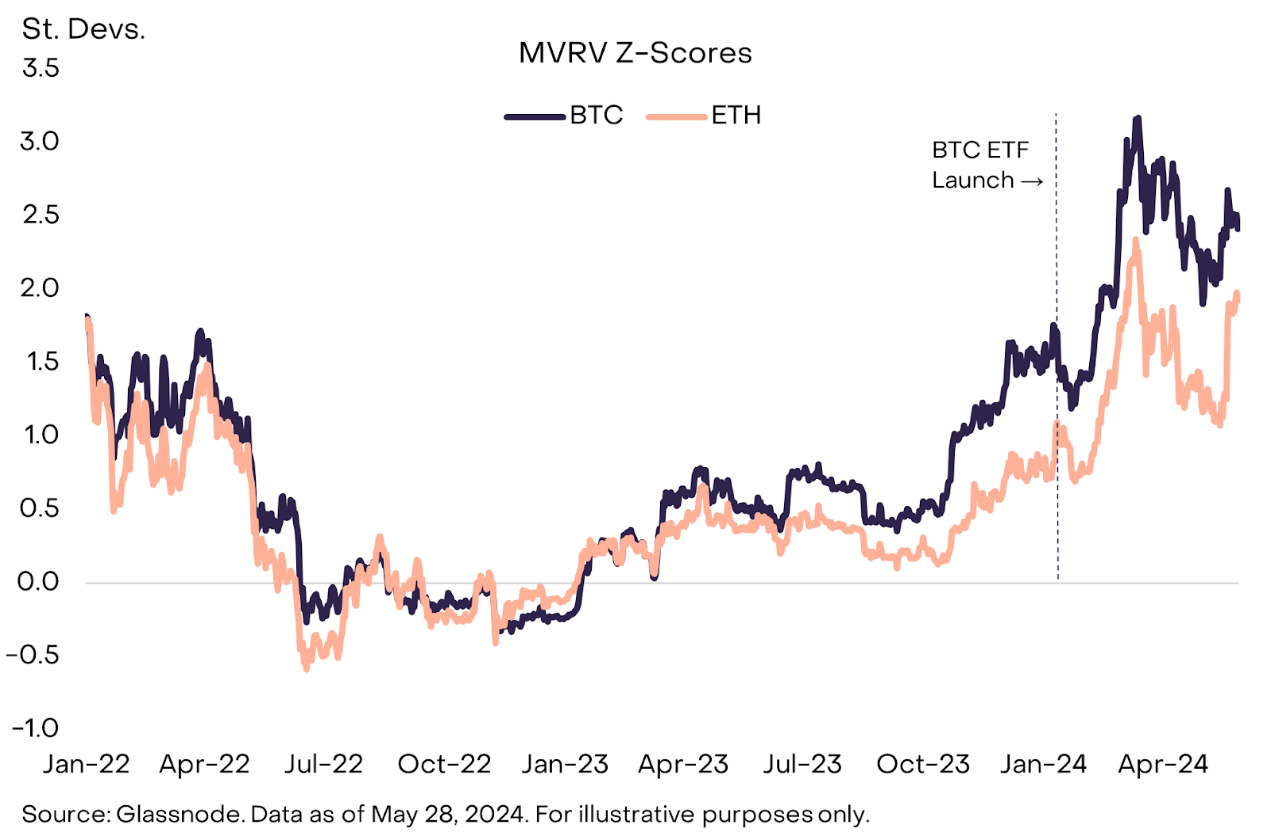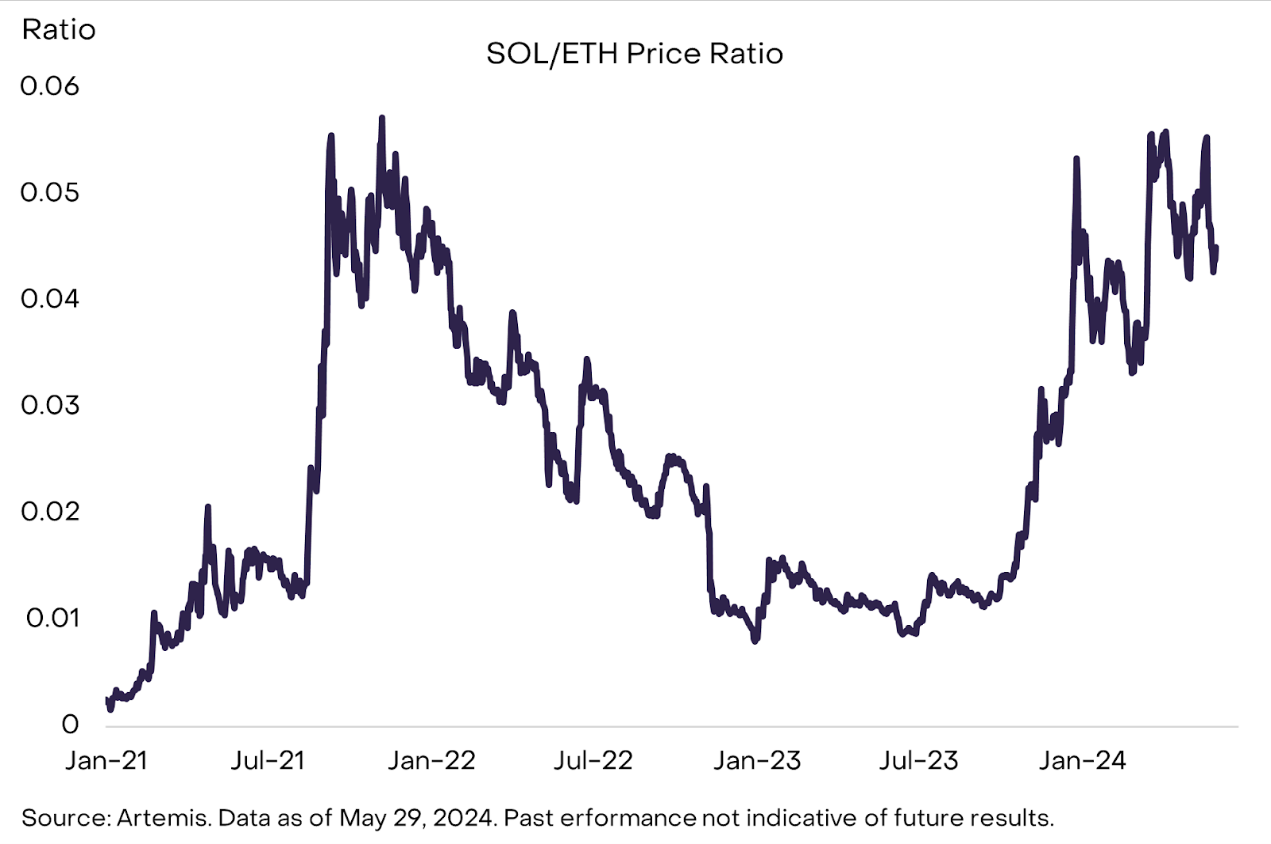Báo cáo của Grayscale: Giá ETH không còn nhiều dư địa để tăng thêm, Solana có thể chiếm lĩnh thị phần
Tác giả gốc: Nghiên cứu thang độ xám
Bản dịch gốc: Felix, PANews
-
Khả năng ra mắt của một ETF Ethereum giao ngay sẽ giúp nhiều nhà đầu tư hiểu rõ hơn về các khái niệm về hợp đồng thông minh và ứng dụng phi tập trung, qua đó giúp họ hiểu được tiềm năng của blockchain công khai trong việc chuyển đổi thương mại kỹ thuật số.
-
Ethereum là mạng lưới blockchain lớn nhất về mặt người dùng và ứng dụng, và đang mở rộng với khái niệm thiết kế mô-đun, với nhiều hoạt động hơn diễn ra trên mạng Lớp 2 trong tương lai. Để duy trì sự thống trị của mình trong phân khúc thị trường cạnh tranh cao, Ethereum cần thu hút nhiều người dùng hơn và tăng thu nhập từ phí.
-
Dựa trên tiền lệ quốc tế, nhu cầu về ETF Ethereum giao ngay của Hoa Kỳ dự kiến sẽ bằng khoảng 25%-30% nhu cầu về ETF Bitcoin giao ngay. Không có khả năng một phần lớn nguồn cung Ethereum (như ETH được đặt cược) sẽ được sử dụng cho ETF.
-
Với mức định giá ban đầu cao, mức tăng giá tiếp theo có thể bị hạn chế so với Bitcoin ETF ra mắt vào tháng 1 năm 2024, nhưng Grayscale Research vẫn lạc quan về triển vọng của cả hai tài sản.
Tuần trước, Ủy ban Chứng khoán và Giao dịch Hoa Kỳ (SEC) đã chấp thuận hồ sơ Biểu mẫu 19 b-4 của một số đơn vị phát hành cho các ETF Ethereum giao ngay, một bước tiến đáng chú ý hướng tới việc niêm yết các sản phẩm này trên các sàn giao dịch của Hoa Kỳ. Tương tự như các ETF Bitcoin giao ngay được niêm yết vào tháng 1, các sản phẩm mới này sẽ cho phép nhiều nhà đầu tư hơn tiếp cận được với các tài sản tiền điện tử. Mặc dù cả hai tài sản đều dựa trên cùng một công nghệ blockchain công khai, Ethereum là một mạng riêng biệt với các trường hợp sử dụng khác nhau (Bảng 1), trong khi Bitcoin chủ yếu đóng vai trò là kho lưu trữ giá trị và giải pháp thay thế kỹ thuật số cho vàng. Ethereum là một nền tảng điện toán phi tập trung với hệ sinh thái ứng dụng phong phú thường được ví như một cửa hàng ứng dụng phi tập trung. Các nhà đầu tư mới quan tâm đến việc khám phá tài sản này có thể muốn xem xét các nguyên tắc cơ bản độc đáo, vị thế cạnh tranh và vai trò tiềm năng của Ethereum trong sự phát triển của thương mại kỹ thuật số dựa trên blockchain.
Hình 1: Ethereum là một nền tảng hợp đồng thông minh blockchain
Cơ bản về hợp đồng thông minh
Ethereum mở rộng tầm nhìn ban đầu của Bitcoin bằng cách thêm hợp đồng thông minh. Hợp đồng thông minh là mã máy tính được lập trình sẵn, tự thực thi. Khi người dùng tham gia hợp đồng thông minh, một hành động được xác định trước sẽ được thực hiện mà không cần bất kỳ đầu vào bổ sung nào. Giống như máy bán hàng tự động: người dùng đưa một đồng xu vào và máy bán hàng tự động sẽ phân phối một mặt hàng. Khi sử dụng hợp đồng thông minh, người dùng đưa một mã thông báo kỹ thuật số vào và phần mềm có thể thực hiện một số loại hành động, chẳng hạn như giao dịch mã thông báo, cấp khoản vay và xác minh danh tính kỹ thuật số của người dùng.
Hợp đồng thông minh hoạt động thông qua các cơ chế của chuỗi khối Ethereum. Ngoài việc ghi lại quyền sở hữu tài sản, các bản cập nhật từng khối của chuỗi khối cũng có thể ghi lại bất kỳ thay đổi nào về trạng thái (lưu ý: thuật ngữ khoa học máy tính có nghĩa là trạng thái của dữ liệu trong cơ sở dữ liệu). Theo cách này, kết hợp với hợp đồng thông minh, chuỗi khối công khai thực sự có thể hoạt động giống như máy tính (máy tính phần mềm chứ không phải máy tính phần cứng). Với điều này, Ethereum và các chuỗi khối nền tảng hợp đồng thông minh khác có thể lưu trữ hầu như mọi loại ứng dụng và đóng vai trò là cơ sở hạ tầng cốt lõi cho nền kinh tế kỹ thuật số mới nổi.
Lợi nhuận tài sản và cơ bản
Kể từ đầu năm 2023, ETH đã hoạt động gần như tương đương với phân khúc token nền tảng hợp đồng thông minh nói chung (Bảng 2). Tuy nhiên, ETH đã hoạt động kém hơn BTC và Solana. Kể từ đầu năm 2023, ETH, giống như BTC, đã hoạt động tốt hơn một số loại tài sản truyền thống trên cơ sở điều chỉnh rủi ro. Về lâu dài, cả BTC và ETH đều đạt được lợi nhuận điều chỉnh rủi ro tương đương với các loại tài sản truyền thống, mặc dù biến động cao hơn đáng kể.
Hình 2: Hiệu suất của ETH phù hợp với lĩnh vực tiền điện tử
Thông qua thiết kế mô-đun của Ethereum, các loại cơ sở hạ tầng blockchain khác nhau hoạt động cùng nhau để cung cấp trải nghiệm tuyệt vời cho người dùng cuối. Đặc biệt, hệ sinh thái mở rộng khi hoạt động trên mạng Ethereum Layer 2 tăng lên. Layer 2 định kỳ giải quyết và công bố hồ sơ giao dịch của mình cho Layer 1, hưởng lợi từ tính bảo mật và phi tập trung của mạng. Cách tiếp cận này trái ngược với các blockchain triết lý thiết kế một lớp như Solana, nơi tất cả các hoạt động chính (thực hiện, giải quyết, đồng thuận và khả dụng dữ liệu) đều diễn ra ở Layer 1.
Vào tháng 3 năm 2024, Ethereum đã trải qua một đợt nâng cấp lớn dự kiến sẽ tạo điều kiện thuận lợi cho quá trình chuyển đổi sang kiến trúc mạng mô-đun. Theo quan điểm của hoạt động blockchain, đợt nâng cấp đã thành công: số lượng địa chỉ hoạt động trên mạng Lớp 2 tăng đáng kể, chiếm khoảng hai phần ba tổng hoạt động trong hệ sinh thái Ethereum (Hình 3).
Hình 3: Hoạt động của Ethereum Layer 2 đã tăng trưởng đáng kể
Đồng thời, sự chuyển dịch sang mạng Lớp 2 cũng ảnh hưởng đến nền kinh tế mã thông báo của ETH, ít nhất là trong ngắn hạn. Các chuỗi khối nền tảng hợp đồng thông minh tích lũy giá trị chủ yếu thông qua phí giao dịch, thường được trả cho người xác thực hoặc được sử dụng để thu hẹp nguồn cung mã thông báo. Trong mạng Ethereum, phí giao dịch cơ bản bị đốt (loại bỏ khỏi lưu thông), trong khi phí ưu tiên (tiền boa) được trả cho người xác thực. Khi doanh thu giao dịch của Ethereum tương đối cao, số lượng mã thông báo bị phá hủy vượt quá tốc độ phát hành mới và tổng nguồn cung ETH giảm (giảm phát). Tuy nhiên, khi hoạt động mạng chuyển sang Lớp 2, doanh thu phí trên mạng chính Ethereum đã giảm và nguồn cung ETH bắt đầu tăng trở lại (Hình 4). Mặc dù các mạng Lớp 2 cũng trả phí để xuất bản dữ liệu của họ lên Lớp 1 (còn gọi là phí blob, cũng như các loại phí giao dịch khác), nhưng số tiền có xu hướng tương đối thấp.
Hình 4: Nguồn cung ETH đã tăng gần đây do phí mạng chính thấp hơn
Để ETH tăng giá trị theo thời gian, mạng chính Ethereum có thể sẽ cần tăng doanh thu phí. Điều này có thể xảy ra theo hai cách:
-
Tăng vừa phải hoạt động Lớp 1, trả phí giao dịch cao hơn
-
Tăng đáng kể hoạt động Lớp 2, trả phí giao dịch thấp hơn
Grayscale Research dự đoán rằng sự kết hợp của cả hai cách tiếp cận có nhiều khả năng xảy ra hơn.
Grayscale tin rằng sự tăng trưởng của hoạt động Lớp 1 rất có thể đến từ các giao dịch có tần suất thấp và giá trị cao, cũng như bất kỳ giao dịch nào yêu cầu mức độ phi tập trung cao (ít nhất là cho đến khi mạng Lớp 2 được phi tập trung đủ). Điều này có thể bao gồm nhiều loại dự án được mã hóa, trong đó chi phí giao dịch có thể tương đối thấp so với giá trị đô la của giao dịch. Hiện tại, khoảng 70% Kho bạc Hoa Kỳ được mã hóa đang nằm trên chuỗi khối Ethereum (Bảng 5). Theo quan điểm của Grayscale, NFT có giá trị tương đối cao cũng có thể vẫn nằm trên mạng chính Ethereum vì chúng được hưởng lợi từ tính bảo mật và phi tập trung cao của nó và ít được trao đổi hơn (vì những lý do tương tự, NFT Bitcoin dự kiến sẽ tiếp tục tăng).
Hình 5: Ethereum lưu trữ phần lớn các chứng khoán kho bạc được mã hóa
Ngược lại, các giao dịch có tần suất tương đối cao và/hoặc giá trị thấp sẽ diễn ra nhiều hơn trên các mạng Lớp 2 khác nhau của Ethereum. Ví dụ, các ứng dụng truyền thông xã hội, những câu chuyện thành công gần đây trên Lớp 2 của Ethereum, bao gồm friend.tech (Base), Farcaster (OP Mainnet) và Fantasy Top (Blast). Theo quan điểm của Grayscale, cả trò chơi và thanh toán bán lẻ đều có thể yêu cầu chi phí giao dịch rất thấp và có nhiều khả năng di chuyển sang các mạng Lớp 2. Tuy nhiên, điều quan trọng cần lưu ý là với chi phí giao dịch thấp, các ứng dụng này cần thu hút một lượng lớn người dùng để tăng đáng kể thu nhập phí của mạng chính Ethereum.
Tác động tiềm tàng của US Spot Ethereum ETF
Về lâu dài, vốn hóa thị trường của ETH sẽ phản ánh thu nhập phí của nó, cũng như các yếu tố cơ bản khác. Nhưng về ngắn hạn, giá thị trường của ETH có thể bị ảnh hưởng bởi những thay đổi về cung và cầu. Mặc dù đã có tiến triển trong việc phê duyệt các ETF Ethereum giao ngay tại Hoa Kỳ, nhưng các đơn vị phát hành ETF vẫn cần phải đợi tuyên bố đăng ký S-1 có hiệu lực trước khi họ có thể bắt đầu giao dịch. Việc phê duyệt hoàn toàn và ra mắt giao dịch các sản phẩm này có thể mang lại nhu cầu mới vì các tài sản sẽ có sẵn cho nhiều nhà đầu tư hơn. Với động lực cung và cầu, Grayscale Research kỳ vọng rằng khả năng tiếp cận Ethereum và giao thức Ethereum sẽ tăng lên thông qua các lớp bọc ETF, điều này sẽ giúp thúc đẩy nhu cầu tăng lên và ngược lại, giá của mã thông báo cũng tăng theo.
Bên ngoài Hoa Kỳ, cả sản phẩm giao dịch trao đổi (ETP) Bitcoin và Ethereum đều được niêm yết, với tài sản trong ETP Ethereum chiếm khoảng 25%-30% tài sản ETP Bitcoin (Bảng 6). Trên cơ sở này, Grayscale Researchs dự báo rằng dòng tiền ròng chảy vào các ETF Ethereum giao ngay được niêm yết tại Hoa Kỳ sẽ đạt 25%-30% dòng tiền ròng chảy vào các ETF Bitcoin giao ngay cho đến nay; hoặc khoảng $3,5 tỷ đến $4 tỷ dòng tiền chảy vào trong bốn tháng đầu tiên hoặc lâu hơn (chiếm 25%-30% trong số $13,7 tỷ dòng tiền ròng chảy vào các ETF Bitcoin giao ngay kể từ tháng 1). Vốn hóa thị trường của Ethereum chiếm khoảng một phần ba vốn hóa thị trường của Bitcoin (33%), do đó, giả định của Grayscale có nghĩa là dòng tiền ròng chảy vào Ethereum có thể chiếm một phần nhỏ hơn một chút trong vốn hóa thị trường. Nhưng đây chỉ là một giả định, và có sự không chắc chắn về dòng tiền ròng cao hơn và thấp hơn vào các ETF Ethereum giao ngay được niêm yết tại Hoa Kỳ. Điều đáng nói là tại thị trường Hoa Kỳ, các ETF tương lai ETH chỉ chiếm khoảng 5% tài sản ETF tương lai BTC, mặc dù điều này không đại diện cho nhu cầu có thể có đối với các ETF ETH giao ngay.
Hình 6: Bên ngoài Hoa Kỳ, tài sản Ethereum ETP được quản lý chiếm 25%-30% tài sản Bitcoin ETP được quản lý
Về nguồn cung ETH, Grayscale Research tin rằng khoảng 17% ETH có thể được phân loại là nhàn rỗi hoặc tương đối kém thanh khoản. Theo dữ liệu từ Allium, một nền tảng phân tích dữ liệu, khoảng 6% nguồn cung ETH đã không di chuyển trong hơn năm năm và khoảng 11% nguồn cung ETH bị khóa trong nhiều hợp đồng thông minh khác nhau (ví dụ: cầu nối, ETH được gói gọn và nhiều ứng dụng khác). Ngoài ra, 27% nguồn cung ETH được thế chấp. Gần đây, các đơn vị phát hành ETF Ethereum giao ngay, bao gồm cả Grayscale, đã xóa các tham chiếu đến các khoản thế chấp khỏi các tài liệu công khai, cho thấy rằng SEC của Hoa Kỳ có thể cho phép ETF giao dịch mà không cần thế chấp. Do đó, phần nguồn cung này khó có thể có sẵn để mua ETF.
Ngoài các danh mục này, $2,8 tỷ ETH được sử dụng cho các giao dịch mạng mỗi năm. Theo giá ETH hiện tại, điều này tương ứng với 0,6% nguồn cung bổ sung. Ngoài ra còn có các giao thức nắm giữ một lượng lớn ETH trong kho bạc của họ, bao gồm Ethereum Foundation ($1,2 tỷ ETH), Mantle (~$879 triệu ETH) và Golem ($995 triệu ETH). Nhìn chung, ETH trong kho bạc giao thức chiếm khoảng 0,7% nguồn cung. Cuối cùng, khoảng 4 triệu ETH, hoặc 3% tổng nguồn cung, được nắm giữ trong ETH ETP.
Tổng cộng, các danh mục này chiếm khoảng 50% nguồn cung ETH, mặc dù có một số chồng chéo (ví dụ: ETH trong các thư viện giao thức có thể được đặt cọc) (Hình 7). Grayscale tin rằng các giao dịch mua ròng ETH có nhiều khả năng đến từ nguồn cung lưu hành còn lại. Vì mức sử dụng hiện tại hạn chế nguồn cung khả dụng cho các sản phẩm ETF giao ngay mới, nên bất kỳ sự gia tăng nhu cầu nào cũng có thể có tác động lớn hơn đến giá.
Hình 7: Một phần đáng kể nguồn cung ETH không thể tham gia vào các ETF giao ngay mới
Theo quan điểm định giá, Ethereum được cho là có giá trị cao hơn Bitcoin khi ETF Bitcoin giao ngay ra mắt vào tháng 1. Ví dụ, một số liệu định giá phổ biến là điểm số z MVRV. Số liệu này dựa trên tỷ lệ vốn hóa thị trường tổng thể của một mã thông báo so với "giá trị thực tế" của nó: vốn hóa thị trường dựa trên giá mà mã thông báo di chuyển lần cuối trên chuỗi (trái ngược với giá mà nó được giao dịch trên sàn giao dịch). Khi ETF Bitcoin giao ngay ra mắt vào tháng 1, điểm số z MVRV của nó tương đối thấp, cho thấy mức định giá khiêm tốn và có khả năng tăng giá nhiều hơn. Kể từ đó, thị trường tiền điện tử đã tăng giá và tỷ lệ MVRV của cả Bitcoin và Ethereum đều tăng (Bảng 8). Điều này có thể chỉ ra rằng có ít chỗ để tăng giá hơn sau khi ETF ETH giao ngay được chấp thuận tại Hoa Kỳ so với tháng 1 khi ETF Bitcoin giao ngay được chấp thuận.
Hình 8: Khi ETF Bitcoin giao ngay được ra mắt, các chỉ số định giá ETH cao hơn BTC
Cuối cùng, các nhà đầu tư tiền điện tử bản địa có thể quan tâm đến tác động của ETF Ethereum giao ngay đối với các token nền tảng hợp đồng thông minh, cụ thể là tỷ lệ giá SOL/ETH. Solana là tài sản lớn thứ hai trong phân khúc này (theo vốn hóa thị trường). Grayscale Research tin rằng Solana hiện có nhiều khả năng sẽ chiếm thị phần từ Ethereum trong dài hạn. Solana đã vượt trội hơn đáng kể so với Ethereum trong năm qua, với tỷ lệ giá SOL/ETH hiện gần với đỉnh của đợt tăng giá tiền điện tử gần đây nhất (Hình 9). Điều này có thể một phần là do thực tế là mặc dù Solana bị ảnh hưởng bởi sự cố FTX (về quyền sở hữu token và hoạt động phát triển), cộng đồng người dùng và nhà phát triển của mạng Solana vẫn tiếp tục phát triển hệ sinh thái. Quan trọng hơn, Solana cũng đã thúc đẩy hoạt động giao dịch và thu nhập phí tăng lên thông qua trải nghiệm người dùng mượt mà. Trong ngắn hạn, Grayscale kỳ vọng tỷ lệ giá SOL/ETH sẽ ổn định khi dòng tiền từ ETF Ethereum sẽ hỗ trợ giá ETH. Tuy nhiên, về lâu dài, tỷ lệ giá SOL/ETH có khả năng sẽ được xác định bởi thu nhập phí của cả hai chuỗi.
Hình 9: Tỷ lệ giá SOL/ETH gần với mức cao của chu kỳ trước
Nhìn về phía trước
Trong khi việc ra mắt một ETF ETH giao ngay tại thị trường Hoa Kỳ có thể có tác động ngay lập tức đến định giá ETH, thì tác động của sự chấp thuận theo quy định còn vượt xa giá cả. Ethereum cung cấp một khuôn khổ thay thế cho thương mại kỹ thuật số dựa trên các mạng phi tập trung. Trong khi trải nghiệm trực tuyến truyền thống khá tốt, các blockchain công khai có thể cung cấp nhiều khả năng hơn, bao gồm thanh toán xuyên biên giới gần như ngay lập tức, quyền sở hữu kỹ thuật số thực sự và các ứng dụng có thể tương tác. Trong khi các nền tảng hợp đồng thông minh khác cũng có thể cung cấp các chức năng thiết thực như vậy, thì hệ sinh thái Ethereum có nhiều người dùng nhất, nhiều ứng dụng phi tập trung nhất và nhóm tiền sâu nhất. Grayscale Research hy vọng rằng ETF giao ngay mới có thể phổ biến công nghệ mang tính chuyển đổi này đến nhiều nhà đầu tư và người quan sát khác hơn và giúp đẩy nhanh việc áp dụng các blockchain công khai.
Bài viết này có nguồn từ internet: Báo cáo của Grayscale: Giá ETH không còn nhiều dư địa để tăng thêm, Solana có thể chiếm lĩnh thị phần
Có liên quan: Diễn giải thị trường: Mùa hè thanh khoản kinh tế vĩ mô có thể đến
Tác giả gốc: Raoul Pal Bản dịch gốc: TechFlow Một số người đang nói về vùng chuối (ám chỉ giá bắt đầu tăng sau khi vượt qua điểm uốn, giống như một quả chuối thẳng đứng có đáy cong và đỉnh thẳng đứng), vì vậy hãy để tôi làm rõ. Mùa hè và mùa thu kinh tế vĩ mô được thúc đẩy bởi chu kỳ thanh khoản toàn cầu. Kể từ năm 2008, chu kỳ thanh khoản toàn cầu đã cho thấy bản chất chu kỳ rõ ràng. Tại sao lại chọn bắt đầu phân tích từ năm 2008? Năm nay, nhiều quốc gia trên thế giới đã thiết lập lại khoản thanh toán lãi suất của họ về 0 và điều chỉnh thời hạn đáo hạn nợ của họ thành 3 đến 4 năm, tạo ra một chu kỳ vĩ mô hoàn hảo. Trong chỉ số của Viện Quản lý Cung ứng Công nghiệp (ISM), chúng ta có thể quan sát thấy tính chu kỳ hoàn hảo của chu kỳ kinh doanh, đây là một trong những chỉ số tốt nhất…
